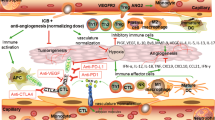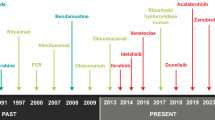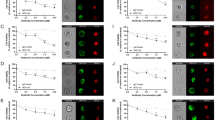Abstract
We have previously shown that thalidomide and its potent immunomodulatory derivatives (IMiDs) inhibit the in vitro growth of multiple myeloma (MM) cell lines and patient MM cells that are resistant to conventional therapy. In this study, we further characterize the effect of these drugs on growth of B cell malignancies and angiogenesis. We established a beige-nude-xid (BNX) mouse model to allow for simultaneous in vivo measurement of both anti-tumor and anti-angiogenic effects of thalidomide and its analogs. Daily treatment (50 mg/kg/d) with thalidomide or IMiDs was nontoxic. The IMiDs were significantly more potent than thalidomide in vivo in suppressing tumor growth, evidenced by decreased tumor volume and prolonged survival, as well as mediating anti-angiogenic effects, as determined by decreased microvessel density. Our results therefore show that the IMiDs have more potent direct anti-tumor and anti-angiogenic effects than thalidomide in vivo, providing the framework for clinical protocols evaluating these agents in MM and other B cell neoplasms.
This is a preview of subscription content, access via your institution
Access options
Subscribe to this journal
Receive 12 print issues and online access
$259.00 per year
only $21.58 per issue
Buy this article
- Purchase on Springer Link
- Instant access to full article PDF
Prices may be subject to local taxes which are calculated during checkout



Similar content being viewed by others
References
Vacca, A, Ribatti, D, Presta, M, Minischetti, M, Iurlaro, M, Ria, R, Albini, A, Bussolino, F & Dammacco, F. Bone marrow neovascularization, plasma cell angiogenic potential, and matrix metalloproteinase-2 secretion parallel progression of human multiple myeloma. Blood, (1999). 93, 3064–3073.
Ribatti, D, Vacca, A, Nico, B, Quondamatteo, F, Ria, R, Minischetti, M, Marzullo, A, Herken, R, Roncali, L & Dammacco, F. Bone marrow angiogenesis and mast cell density increase simultaneously with progression of human multiple myeloma. Br J Cancer, (1999). 79, 451–455.
Rajkumar, SV, Leong, T, Roche, PC, Fonseca, R, Dispenzieri, A, Lacy, MQ, Lust, JA, Witzig, TE, Kyle, RA, Gertz, MA & Greipp, PR Prognostic value of bone marrow angiogenesis in multiple myeloma. Clin Cancer Res, (2000). 6, 3111–3116.
D'Amato, RJ, Loughman, MS, Flynn, E & Folkman, J Thalidomide is an inhibitor of angiogenesis. Proc Natl Acad Sci USA, (1994). 91, 4082–4085.
Singhal, S, Mehta, J, Desikan, R, Ayers, D, Roberson, P, Eddlemon, P, Munshi, N, Anaissie, E, Wilson, C, Dhodapkar, M, Zeddis, J & Barlogie, B Anti-tumor activity of thalidomide in refractory multiple myeloma. N Engl J Med, (1999). 341, 1565–1571.
Davies, FE, Raje, N, Hideshima, T, Lentzsch, S, Young, G, Tai, YT, Lin, B, Podar, K, Gupta, D, Chauhan, D, Treon, SP, Richardson, PG, Schlossman, RL, Morgan, GJ, Muller, GW, Stirling, DI & Anderson, KC Thalidomide and immunomodulatory derivatives augment natural killer cell cytotoxicity in multiple myeloma. Blood, (2001). 98, 210–216.
Anderson, KC Thalidomide: therapeutic potential in hematologic malignancies. Semin Hematol, (2000). 37, 1–4.
Raje, N & Anderson, KC Thalidomide: A revival story. N Engl J Med, (1999). 341, 1606–1609.
Muller, G, Chen, R, Huang, S, Corral, L, Wong, L, Patterson, R, Chen, Y, Kaplan, G & Stirling, DI Amino-substituted thalididomide analogs: potent inhibitors of TNF-a production. Bioorg Med Chem, (1999). 9, 1625–1630.
Hideshima, T, Chauhan, D, Shima, Y, Raje, N, Davies, FE, Tai, YT, Treon, SP, Lin, B, Schlossman, RL, Richardson, P, Muller, G, Stirling, DI & Anderson, KC Thalidomide and its analogs overcome drug resistance of human multiple myeloma cells to conventional therapy. Blood, (2000). 96, 2943–2950.
Gupta, D, Treon, SP, Shima, Y, Hideshima, T, Podar, K, Tai, YT, Lin, B, Lentzsch, S, Davies, FE, Chauhan, D, Schlossman, RL, Richardson, P, Ralph, P, Wu, L, Payvandi, F, Muller, G, Stirling, DI & Anderson, KC Adherence of multiple myeloma cells to bone marrow stromal cells upregulates vascular endothelial growth factor secretion: therapeutic applications. Leukemia, (2001). 15, 1950–1961.
Verheul, HM, Panigrahy, D, Yuan, J & D'Amato, RJ Combination oral antiangiogenic therapy with thalidomide and sulindac inhibits tumour growth in rabbits. Br J Cancer, (1999). 79, 114–118.
Drexler, HG, MacLeod, RA & Dirks, WG Cross-contamination: HS-Sultan is not a myeloma but a Burkitt lymphoma cell line. Blood, (2001). 98, 3495–3496.
Weidner, N, Semple, JP, Welch, WR & Folkman, J Tumor angiogenesis and metastasis – correlation in invasive breast carcinoma. N Engl J Med, (1991). 324, 1–8.
Corral, LG Immunmodulation by thalidomide and thalidomide analogues. Am Rheum Dis, (1999). 58, 1107–1113.
Corral, LG, Haslett, PAJ, Muller, GW, Chen, R, Wong, L-M, Ocampo, CJ, Patterson, RT, Stirling, DI & Kaplan, G Differential cytokine modulation and T cell activation by two distinct classes of thalidomide analogues that are potent inhibitors of TNF-α. J Immunol, (1999). 163, 380–386.
Richardson, PG, Schlossman, RL, Weller, E, Hideshima, T, Mitsiades, C, Davies, F, LeBlanc, R, Catley, LP, Doss, D, Kelly, K, McKenney, M, Mechlowicz, J, Freeman, A, Deocampo, R, Rich, R, Ryoo, JJ, Chauhan, D, Balinski, K, Zeldis, J & Anderson, KC Immunomodulatory derivative of thalidomide CC-5013 overcomes drug resistance and is well tolerated in patients with relapsed multiple myeloma. Blood, (2002). (in press)
Acknowledgements
This work was supported by the Deutsche Krebshilfe, Bonn, Germany (SL), National Institutes of Health Grants RO-1 50947 and PO-1 78378, and the Doris Duke Distinguished Clinical Research Scientist Award (KCA).
Author information
Authors and Affiliations
Rights and permissions
About this article
Cite this article
Lentzsch, S., LeBlanc, R., Podar, K. et al. Immunomodulatory analogs of thalidomide inhibit growth of Hs Sultan cells and angiogenesis in vivo. Leukemia 17, 41–44 (2003). https://doi.org/10.1038/sj.leu.2402745
Received:
Accepted:
Published:
Issue Date:
DOI: https://doi.org/10.1038/sj.leu.2402745
Keywords
This article is cited by
-
Bioequivalence study of single-dose lenalidomide capsule vs. Revlimid® capsule in healthy Chinese males
Cancer Chemotherapy and Pharmacology (2018)
-
Lenalidomide potentiates CD4+CD25+Treg-related suppression of lymphoma B-cell proliferation
Clinical and Experimental Medicine (2017)
-
Expression of the cereblon binding protein argonaute 2 plays an important role for multiple myeloma cell growth and survival
BMC Cancer (2016)
-
Changing treatment paradigms in lymphoma: new targets and new drugs
memo - Magazine of European Medical Oncology (2015)
-
Pomalidomide: First Global Approval
Drugs (2013)



